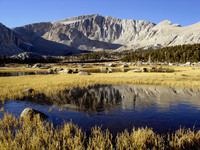Topo map USGS Mount Langley First ascent 1871 Mountain range Sierra Nevada Parent range Sierra Nevada | Elevation 4,275 m Prominence 355 m | |
 | ||
Easiest route Hike from New Army Pass on the south, class 1 Similar Mount Whitney, Split Mountain, Mount Muir, Mount Tyndall, Mount Russell | ||
First solo backpacking trip cotton wood lakes to mount langley attempt
Mount Langley is located on the crest of the Sierra Nevada, on the boundary between Inyo and Tulare counties, in eastern California in the southwestern United States. To the east is Owens Valley, and to the west is the Kern River Valley. It is the ninth-highest peak in the state and the seventh-highest in the Sierra. Mount Whitney, the highest peak in the contiguous United States, lies 4.8 miles (7.7 km) to the northwest. Mt. Langley also has the distinction of being the southernmost fourteener (peak above 14,000 feet) in the United States.
Contents
- First solo backpacking trip cotton wood lakes to mount langley attempt
- Map of Mt Langley California USA
- HistoryEdit
- ClimbingEdit
- References
Map of Mt Langley, California, USA
HistoryEdit
Today, the mountain is named after Samuel Pierpont Langley. In the early 1870s, it was confused with Mount Whitney by early climbers, and called by this name. When the mistake was realized, the peak was alternately called Mount Corcoran, Cirque Peak, or Sheep Mountain; the former two names being later attached to other mountains. But its current name became established in local usage, and was made official by the Board on Geographic Names in 1943.
ClimbingEdit
Mount Langley is one of the easiest of California's fourteeners to climb. A hiking trail starts at nearby Horseshoe Meadow, at an elevation of about 10,000 feet (3,048 m), passes scenic Cottonwood Lakes, and climbs through New Army Pass. From there hikers travel cross-country to Old Army Pass, where they may pick up the recently constructed Class 1 Mount Langley Trail. Hikers follow a series of large rock cairns for the two mile push to the summit, which includes a short, 20-foot class 3 scramble to the summit. New Army Pass is 7 miles (11 km) from the trailhead at Horseshoe Meadow and is an easier but longer approach to Langley than Old Army Pass.
Due to the elevation, both passes are covered with snow most of the year. New Army Pass sits on a south-facing slope and it tends to clear of snow somewhat earlier in the season. Old Army Pass is only clear of snow for less than two months per year, from mid-August to early October. During the winter months, even the paved road to Horseshoe Meadow is closed, making the summit significantly harder to reach.
The first recorded climb of the mountain was in 1871 by Clarence King and the French mountaineer Paul Pinson.
